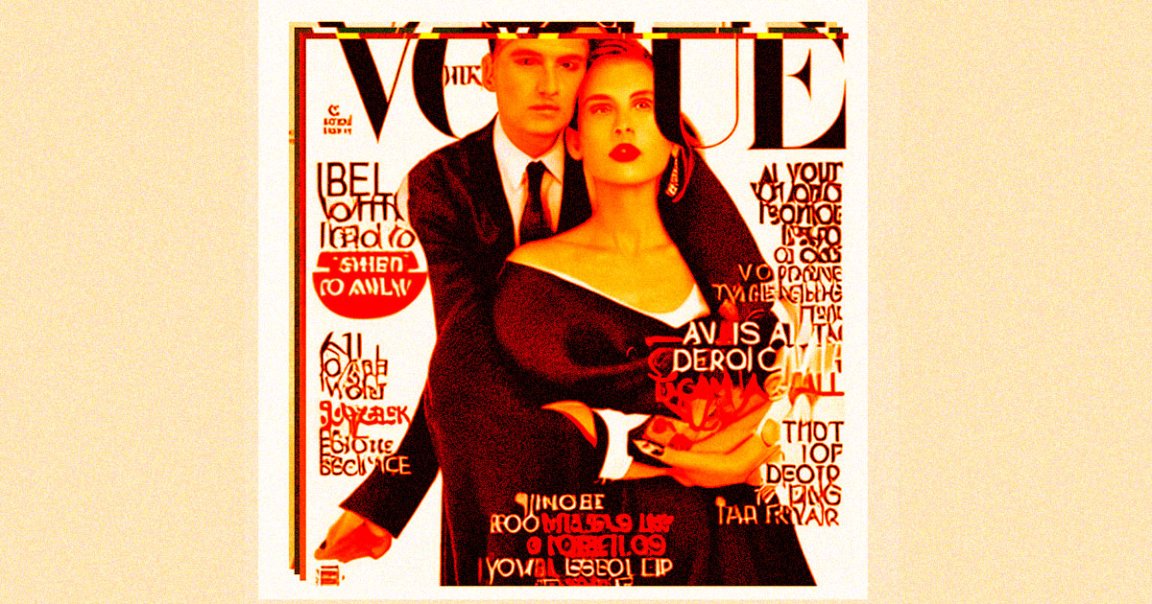
AI-generated imagery has officially made its fashion magazine debut.
Instead of tapping human artists to create fantastical photo shoot backdrops, Vogue Italia’s upcoming May issue will feature scenery that was generated by OpenAI’s viral AI image generator, DALL-E2, instead.
And apart from the fact that some of the images themselves are nightmare fuel — why is there a face sticking out of fashion model Bella Hadid’s head? — we have some bones to pick with the magazine’s decision.
In a press release, Vogue is marketing the creative process behind the images with “‘unreal’ backgrounds” as a “creative collaboration” between humans and machines.
The creatives behind the shoot certainly seem to concur, arguing that working with AI is more complex than one might think.
“Collaborating with AI is a bit like being a ‘curator,’ in charge of assisting the ‘machine’ in its creative process,” photographer Carlijn Jacobs, who created the images alongside stylist Imruh Asha and AI artist Chad Nelson, told Vogue. “In theory, today it is possible to make do without a set designer and ask a computer to produce the objects and set up the lights for a photo shoot. However, you have to consider investing a lot of time and energy to use the AI.”
“The machine does not intrinsically know what is aesthetically pleasing,” she added, “so it’s up to the human to accompany it step by step, showing it what works visually.”
And in some ways, that collaborative element may well ring true. But outside of lauding how the photos represent a “fascinating interplay between human creativity and artificial images,” Vogue’s writeup arguably fails to address any of the more ethically murky realities of creating and commercializing AI-made imagery.
As it stands, there’s already at least one ongoing lawsuit concerning AI-generated art, leveraged by artists against OpenAI rivals Midjourney and Stable Diffusion. Without any form of compensation, artists’ work has been used by AI companies to train their image-generating models, tainting their output with copyright-infringing material.
Commercializing those outputs on newsstands feels like an escalation of that trend.
Then there are the ethics of replacing human work with machine labor. In the article, Asha, the shoot’s stylist, posited that “in the future, we will see more and more images produced with artificial intelligence,” but argued that “the desire for photo shoots marked by authenticity, with real objects and backgrounds and models in the flesh, will not diminish.”
While it’s a comforting thought, the reality is that some artists have already lost work as a result of their employers making use of AI. And Vogue Italia, it’s worth noting, isn’t exactly a small operation. It likely has deep enough pockets to pay humans for their work, and the imagery that the AI created for the photo shoot definitely isn’t outside of the realm of what a human could create.
In other words, it doesn’t bode well when even those with enough resources to cover the cost of human art are arguing that AI is the future.
Besides, the broader media landscape is already going through a rough patch, with fashion publication Paper Mag laying off its entire editorial staff this week.
“Running a ‘we can use AI to replace human creativity’ cover story the day after an entire magazine staff is laid off and ceases production,” tweeted fashion writer Chloe Kennedy. “These are dark times.”
In any case, at least Vogue Italia resisted the urge to use ChatGPT to write the article’s lede.
“We can use AI to replace human creativity, and get lazy, or as a tool to stimulate it, expand it, overcoming its traditional limits,” Jacobs told Vogue. “If we opt for the second option, exciting times await those who, like us, are lucky enough to experience this era working in a creative sector.”
More on AI imagery ethics: Artists Sue Stable Diffusion and Midjourney for Using Their Work to Train AI That Steals Their Jobs